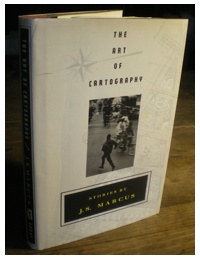 Alfred A. Knopf published J.S. Marcus’ collection of stories, The Art of Cartography in 1991, with a blurb by Amy Hempel: “Dozens of perfectly observed vignettes – the stories within stories – are amplified when Marcus pieces them together.” It can be had now for $1.99 via Alibris.
Alfred A. Knopf published J.S. Marcus’ collection of stories, The Art of Cartography in 1991, with a blurb by Amy Hempel: “Dozens of perfectly observed vignettes – the stories within stories – are amplified when Marcus pieces them together.” It can be had now for $1.99 via Alibris.
These are mostly very truncated stories dealing with Americans who suddenly find themselves forced to identify themselves as Americans, natives of Los Angeles, lawyers, or actors. These definitions are at odds with how they think about themselves. In “The Most Important Thing,” the narrator says, “I am Jewish, with a Jewish name, and because there are so few Jews in this city, I often feel Jewish — at work, for example — by contrast. Sometimes I think of myself a bureaucrat.” They work in Europe or New York alongside Europeans for various global concerns. The identifier “American,” is a tag or identifier that serves to encapsulate them. Encapsulation itself serves as a working structure throughout the entire book. The characters live encapsulated lives, placing themselves in various boxes of identity, as an American banker, for instance.
Marcus is the master of containment. Each paragraph encapsulates a narrative. Like organic cells, they are completely self-sufficient, and yet they specialize and perform specific functions as they build passages and stories. The word encapsulate comes from the French appropriation of the Latin word for box and means a “a membranous sac.” Boxes or cells, each paragraph encapsulates a story.
Gertrude Stein, in her enjoyably impenetrable instruction manual How to Write, discusses the difference between the paragraph and the sentence. She writes that a paragraph, rather than a sentence, has emotion. “This is so light it is an emotion,” she wrote, “and so a paragraph. Yes so a paragraph.” In composition classes, the sentence is described as a complete thought. Yet, what to do with sentence fragments. Students learn to scrub the fragments from their paragraph in order to remove incomplete and dangling thoughts.
If a paragraph has emotion, if a paragraph is itself a unit of expression, it can contain more than complete thoughts organized around thesis and elaboration. It contains half-thoughts, even dangling thoughts.
Here is a paragraph from the story “Words” (without fragments, but still):
My parents had always liked David: his occasional letters, his phone etiquette, his ability to be entertaining but occupied whenever they came over for a visit. But our stay at their house — David first — was a conceded failure. David used my parents as easy targets, and they silently thought him a monster.
This paragraph occurs in a string of similar paragraphs. Each paragraph can be removed from the whole and still function in only 52 words, or 125 words, or 250 words. Hempel’s “stories within in a story” are reflected in each of Marcus’ paragraphs. The sentences in the paragraph from “Words” while grammatical, don’t necessary make for stories. Here the sentences are propositions, enumerated examples, complications, and results. Furthermore, paragraph conveys emotion, as they do in that the narrator’s parents like this character David. But, David is a poor guest, and so the overall emotion is negative, but also empty. The possibility of David being a chummy son-in-law has combusted.
Marcus’ ability to create a situation and then to negate it fills (or rather un-fills) the book. An American, unlike a European, is likely to describe themselves first, even before they say they are an American, a Jew, from Los Angeles, that they are what they do for money. In Marcus’s book they are bankers, music critics, and secretaries. If you ask an European who she is, she is likely, reluctantly to be offended and then tell you where she is from, that is where she was born and went to school. Unlike where someone is from, a job title is another form of encapsulation. A person can be a banker, music critic, or secretary in San Francisco, New York, or Prague. Where they are from is like a resume, Americans alter it to suit their present needs. What they do can be carried with them like a suitcase. Answering that they are a music critic when someone asks them who they are is as useful as holding up their suitcase when someone asks them what they are bringing on the trip.
As containers within containers, Marcus’s stories carefully empty themselves out until we are left with 129 off-white pages printed with W.A. Dwiggins’s Caledonia typeface. Each story, each page, each paragraph, each sentence carefully nested like empty suitcases.
Rediscovered Reading is a regular series in which Matt Briggs reviews overlooked collections of short fiction. Matt is the author of Shoot the Buffalo and other books. He blogs at mattbriggs.wordpress.com.

One Reply
[…] new review on the Rediscovered Reading tag at Fictionaut’s Blog. Marcus’ ability to create a situation […]
Leave a Comment
trackback address